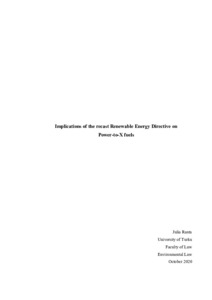Implications of the recast Renewable Energy Directive on Power-to-X fuels
Ranta, Julia (2020-10-27)
Implications of the recast Renewable Energy Directive on Power-to-X fuels
Ranta, Julia
(27.10.2020)
Julkaisu on tekijänoikeussäännösten alainen. Teosta voi lukea ja tulostaa henkilökohtaista käyttöä varten. Käyttö kaupallisiin tarkoituksiin on kielletty.
avoin
Julkaisun pysyvä osoite on:
https://urn.fi/URN:NBN:fi-fe2020111390157
https://urn.fi/URN:NBN:fi-fe2020111390157
Tiivistelmä
This thesis systemises the regulatory framework established by the recast Directive (EU) 2018/2001 on the promotion of the use of energy from renewable sources (RED II) for synthetic Power-to-X (P2X) fuels. The aim is to identify and analyse the key regulatory challenges regarding the exploitation of raw materials, hydrogen and carbon dioxide (CO2), as well as utilisation of the end products. Consequently, challenges regarding the production process of P2X fuels are taken into account. In order to assess the regulatory framework of the P2X fuels, it is essential to comprehend the regulatory environment set forth for hydrogen and CO2, as the origin of the energy and the production process will define whether the P2X fuel falls within the category of renewable liquid and gaseous fuels of non-biological origin (RFNBOs) or recycled carbon fuels (RCFs). In light of my conclusions, I apply the findings made in this thesis in practice by evaluating the regulatory treatment of the P2X Joutseno pilot plant. Lastly, the thesis provides recommendations to develop the regulatory framework at the EU level as well as presents argumentation on how the provisions could be transposed into national legislation to facilitate further deployment of P2X fuels.
The analysis in this thesis is built on legal dogmatics and more specifically, theoretical environmental law. In addition, the tools provided by regulatory theory are utilised in order to take up a more comprehensive approach to the research questions. The primary object of the analysis is RED II. Moreover, to examine further development of the regulatory framework of P2X fuels, emphasis is given to several communications adopted by the European Commission (EC).
Although RED II recognises P2X fuels, the conclusions of this thesis suggest that it seems to lack the ability to adapt evolving technological innovations and the increasing demand for renewable and low-carbon transport fuels. Although further details of RED II are still to be introduced by the delegated acts to be adopted by the EC during 2021, the regulatory architecture and the particular requirements seem to take an overly critical approach towards RCFs and RFNBOs by undermining their potential and establishing unnecessary barriers. Due to these drawbacks, operators lack the encouragement to in-vest in P2X technologies compared to other competing pathways. The deficiencies undermining the appropriate incentives to RFNBOs and RCFs need to be thoroughly ad-dressed to provide adequate regulatory certainty to support the large-scale introduction of P2X fuels.
The analysis in this thesis is built on legal dogmatics and more specifically, theoretical environmental law. In addition, the tools provided by regulatory theory are utilised in order to take up a more comprehensive approach to the research questions. The primary object of the analysis is RED II. Moreover, to examine further development of the regulatory framework of P2X fuels, emphasis is given to several communications adopted by the European Commission (EC).
Although RED II recognises P2X fuels, the conclusions of this thesis suggest that it seems to lack the ability to adapt evolving technological innovations and the increasing demand for renewable and low-carbon transport fuels. Although further details of RED II are still to be introduced by the delegated acts to be adopted by the EC during 2021, the regulatory architecture and the particular requirements seem to take an overly critical approach towards RCFs and RFNBOs by undermining their potential and establishing unnecessary barriers. Due to these drawbacks, operators lack the encouragement to in-vest in P2X technologies compared to other competing pathways. The deficiencies undermining the appropriate incentives to RFNBOs and RCFs need to be thoroughly ad-dressed to provide adequate regulatory certainty to support the large-scale introduction of P2X fuels.
